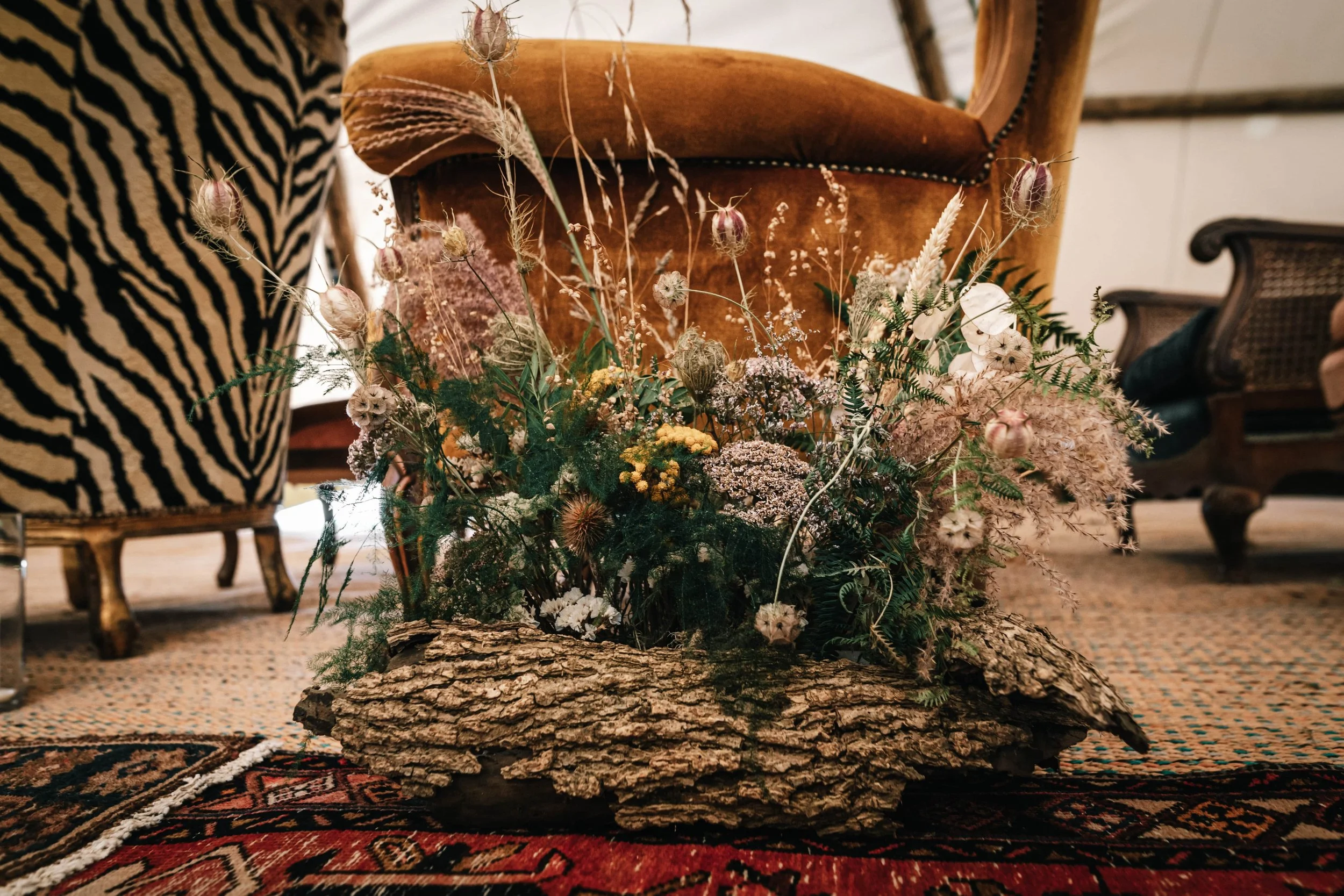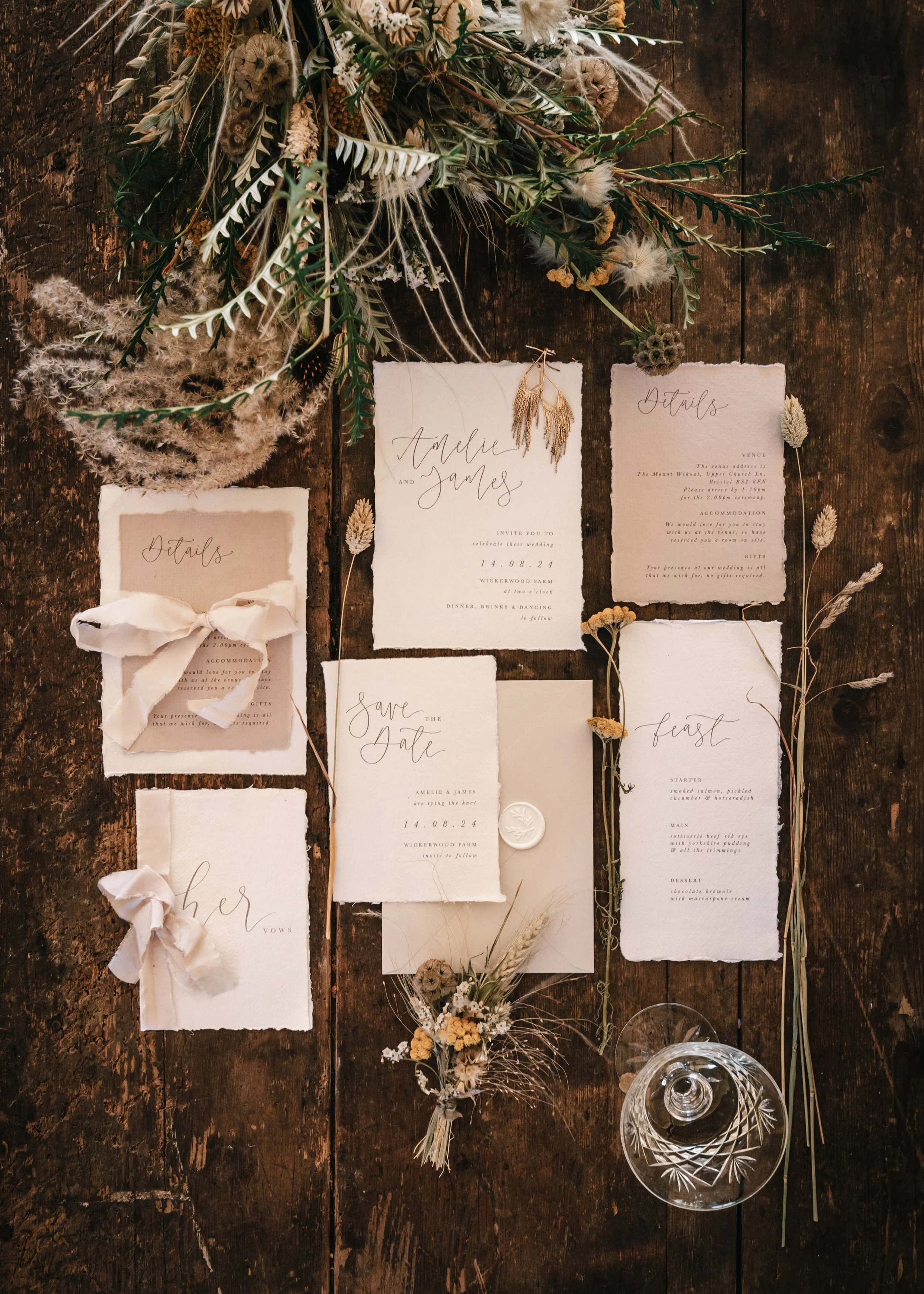Exploring sustainable and sophisticated wedding styling at Wickerwood Farm, Sussex
Weddings can often leave a trail of waste and now more than ever couples are exploring ways to have an environmentally conscious approach to their celebration. As a floral designer deeply rooted in the values of sustainability, I feel that our connection to nature deserves the utmost care and respect, for we are, in essence, bound to its delicate balance. If you're looking to be environmentally conscious with your wedding it starts with appointing suppliers that share this mindset.
So, aiming to inspire a greener narrative, a collection of like-minded creatives came together at the enchanting Wickerwood Farm in Sussex for a collaborative shoot, to demonstrate that being sustainable doesn’t mean you’ll compromise on style or sophistication.
In this feature I’m going to delve into the finer details of the floral designs themselves, the influences, sources and concept creation. I’ll also be sharing top tips for making your wedding florals a powerful ally in the pursuit of a sustainable celebration.
The floral concept
Working closely with and being inspired by the seasons is often where a project concept begins. Being the end of the summer, I wished to celebrate the turn of the seasons, combining both fresh and dried natural florals from British growers. I also wanted to give a nod to the location- Wickerwood Farm so I foraged bark from the woodland floor as an extra natural texture element that was used to form the base / 'vessel’ of the aisle and table designs.
The colour palette was influenced by the season and the surroundings. We were in late summer, and the bold and bright tones of the months before were now turning into warmer and sun baked neutral palettes. Wickerwood farm had a field of yellow wildflowers in bloom at the time, so including a pop of this colour elegantly contrasted the neutrals and greens, and tied the designs to the surrounding landscape. Furthermore, it ended up being beautiful sunshine for the day, but we wanted to demonstrate an ‘indoor’ ceremony setting within the tipi as we all know you can’t rely on the British weather! So, the neutral tone of the canvas further influenced incorporating beige and brown tones. For a real wedding of course, the ceremony design is made on site on the wedding morning so it could have been created for an outdoor setting and all the portable additional arrangements placed accordingly too.
As always, all designs were to be created without floral foam as this product used in traditional floristry is bad news for the environment (find out why here) so reusable chicken wire, water vials and flower frogs were used to support the florals.
My style of work can be considered gardenesque, elegant, naturalistic and contemporary and this aesthetic leant itself well to what we wanted to achieve with this shoot, complementing the romantic, boho and rustic wider styling details.
The Floral Designs
For the bridal bouquet, I wanted to demonstrate a design that could last beyond the wedding day. So I sourced a mix of already dry natural ingredients and then incorporated some fresh greenery that dries well to contrast against the neutral elements and enrich the overall palette. Trailing silk ribbons naturally dyed with botanicals were added to further enhance the elegance and introduce a delicately contrasting texture.
For the ceremony arch, the structure was built from two huge tree branches of which I opted to keep the smaller branches on too. Chicken wire was attached in sections to support the stems and any ingredients that required a water source had small reusable water tubes attached. It featured Surrey grown dahlias, rudbeckia, asparagus fern, achillea and zinnias purposely presented in a layered, textural and wild form, creating an organic feel. Whilst it’s not often possible to move arch designs you can utilise them later in your day as a unique photographic backdrop to some portraits.
The aisle and table designs were created with chicken wire mechanics in watertight vessels which were then disguised with the bark pieces. To bring some height and a ‘growing there’ look I used architectural seed heads, grasses and delicate ferns. These were then moved to style focal areas like the cake table and a lounge suite coffee table later in the day. Repurposing floral arrangements from the ceremony is always a great idea to get the most from them.
Further Styling
It was really inspiring to collaborate with like minded creatives and each share our sustainability practices in our areas of expertise. Some features from my colleagues that I particularly loved are lightly explored in the following section. Wickerwood Farm itself holds the environment at the heart of it’s boutique wedding venue ethos, with protected soil and hedgerows and limited events held per season to allow for regeneration and maintenance of its serene natural surroundings. Furthermore Jude, the owner and force behind the farm, has an incredible collection of styling and prop items including vintage chairs and lounge sets. This is not only great in terms of utilising preloved pieces but also allows for a unique (and far more comfortable!) ceremony setting.
Furthermore the stationary suite from Lou Paper was printed on handmade paper created from recycled, raw and natural ingredients, this is not only a kinder practice but gave a beautiful organic look and feel to the product. The bridal ware dress and jumpsuit were sourced from a clothing marketplace, new with tags, but with the planet benefit of being rescued from unwanted hands rather than a retail source. The tableware hired from A touch of vintage again celebrates pre-loved and reusing.
So, I hope that provided some insight and inspiration! Circling back to the florals now, I’ll round off this piece with some key tips for having beautiful florals that keep sustainability at heart.
Make sure your florist does not use floral foam- the product is the biggest polluter of the industry.
Choose a florist that supports and utilises the British flower market.
Be open to seasonal flowers and trust your florist in sourcing the best naturally thriving blooms of the moment that complement the colour and design aesthetic of your day. This will enable the highest quality of ingredients and those with the lowest planet impact.
Opt for natural silk ribbons on your bouquet over manufactured materials like satin.
Consider dried florals within the palette, Autumn and Winter especially. This allows for greater abundance of designs with reduced volume of imported ingredients.
Repurposing- making the most of your floral designs by moving them to style another space can be a great way of essentially recycling them. Designs that line the aisle for example can be distributed to other areas such as the cake table, bar, lounge area. They can also be combined to make a feature piece, in front of the top table for example or on a venue feature like a fireplace.
Ensure the ingredients your florist uses are all natural- no dyed, glittered or artificial, as these products cannot be safely composted.
Thank you for reading!
Interested in learning more about sustainable florals for your wedding? I’d love to speak with you! Drop me an enquiry to begin.
Full shoot team
Photography & coord | Sarah Carmody Photography
Venue, concept, coord, styling & prop hire | Wickerwood Farm
Tipi, table and chair hire | Love Tipis
Florist | Made with Grace Floral Design
Hair Stylist | Simply Beautiful wedding hair
MUA | Kate Waller Hair and Make up
Models | Naomi Faith & Dirico Fit Coaching
Stationer | Lou Paper
Cake Maker | Love From Luisa Cakes
Tableware | A Touch Of Vintage
Bell Tents | Beneath The Canopy
Bridal Wear | Ghost London Bridal & Reformation (Purchased from Auction Site)
Featured | County Wedding Magazines - Sussex Oct/Nov 23 edition and Green Union.






















